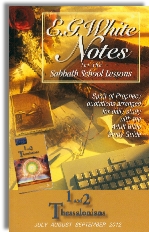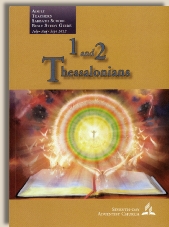|
||||||||||||||
Commentary on "Thessalonica in Paul's Day"
Day 3: Monday, July 16, 2012 - A Pagan Response to Rome
Overview
Today's lesson continues the description of the political setting in which Paul's epistle to the Thessalonians was written. While yesterday the focus was the unrest and desire for change generated by Rome's alien domination, today the attention concentrates on the reaction and response found in the movement initiated by Cabirus, which, after his death, became a cult. Cabirus was a spokesperson for the disenfranchised and was murdered by his two brothers, becoming a mythical subject. To him were attributed miraculous powers, and even after his death people believed that he returned from time to time to help individuals. Eventually he would make a final return to do justice for the lower classes and to restore Thessalonica's former independence. The cult involved blood sacrifices commemorating his martyrdom while the language of participating in Cabirus' blood, similar to the words used by Paul with reference to Jesus, was used. When Rome's imperial cult appeared, the cult and name of Cabirus was hijacked for imperial use, making anyone's claim to be a reincarnation or continuation of Cabirus illegal, an enemy of the emperor, the "real" embodiment of Cabirus' spirit. Because of Rome's take-over of the cult of Cabirus, the lower class was left in a spiritual vacuum which Jon Paulien sees as filled only by Jesus Christ. The solution brought by Jesus was inner peace in the present and political-economic reversals at the end.
Observations
Those who have read this quarter's introduction know that I highlighted the common themes and ideas Jon Paulien shares with liberal theologians like Bart Ehrman who reject Pauline authorship of 2nd Thessalonians due to their interpretation of it as antithetical to Paul's message in 1st Thessalonians. Today Jon Paulien construes another case in favor of theological liberalism; his assumptions, if accepted and consistently followed, will lead people right into a rejection of Christian faith.
The bestselling Da Vinci Code charged that everything of importance in Christianity, from communion to Jesus' birthday to Sunday worship, was "taken directly from earlier pagan mystery religions". Other writings draw parallels between Jesus and Osiris, or Mithras, and some details sound familiar. For example, they said that the pre-Christian god Mithras was born of a virgin in a cave on December 25, was considered a great traveling teacher, had twelve disciples, promised his followers immortality, sacrificed himself for world peace, was buried in a tomb and rose again three days later, instituted a Eucharist or "Lord's Supper," and was considered the Logos, redeemer, Messiah, and "the way, the truth, and the life." Since those myths are considered the natural product of people's aspirations, Jesus is seen as nothing else than the product of a similar desire. Cabirus' myth falls in the same category, and in this setting it is strange for Paulien to insist on the similarities between Cabirus' myth and Jesus' story, since Cabirus' non-historical resurrection doesn't fit with Jesus physical and real resurrection.
The Christian defense was to point first to the historical nature of the resurrection, and also to the fact that the Greek myths were related to the seasonal life-and-death cycle of vegetation. In contrast Jesus' resurrection is a single event, is not related to the cycle of vegetation, and has a redemptive purpose related to sin and atonement. This central element that gives a unique significance to Jesus' death is completely lacking from Cabirus' and other myths. First and foremost Jesus' death had a goal and satisfied a need that is completely absent from the needs expressed by the ancient myths, including Cabirus.
Cabirus' myth doesn't reflect man's desire for an atonement for sins, it only reflects the political desires of the population to get rid of the Roman domination. These are precisely the same desires which the Jews in Judea had, and for whom Jesus was such a disappointment. He was not a zealot, he was not a "freedom fighter", He came to liberate people from his sins, as Zechariah, the father of John the Baptist prophesied:
And you, child, will be called the prophet of the Most High; for you will go before the Lord to prepare his ways, to give knowledge of salvation to his people in the forgiveness of their sins (Luke 1:76-77 ESV)
In conclusion, not only was Jesus' story quite different than Cabirus' story, but the expectations of the people reflected in the myth and cult of Cabirus were antithetical to a favorable reception of the gospel. Sin and salvation from it's guilt, power and presence are completely missing categories, and precisely for these fundamental problems the gospel is offered as a solution. Not only Cabirus' myth and the political setting of Thessalonica was not favorable to a reception of the gospel, it was instead a hindrance and a motivation to look after another savior, after another political revolutionary, after somebody more akin to Che Guevara.
Copyright 2012 BibleStudiesForAdventists.com. All rights reserved. Revised July 15, 2012. This website is published by Life Assurance Ministries, Camp Verde, Arizona, USA, the publisher of Proclamation! Magazine. Contact email: BibleStudiesForAdventists@gmail.com.
The Sabbath School Bible Study Guide and the corresponding E.G. White Notes are published by Pacific Press Publishing Association, which is owned and operated by the Seventh-day Adventist church. The current quarter's editions are pictured above.
Official Adventist Resources
Standard Edition Study Guide Week 3
Teacher's Edition Study Guide Week 3
Easy Reading Edition Study Guide Wk 3
Search the Complete Published Ellen G. White Writings
Please Support This Project


